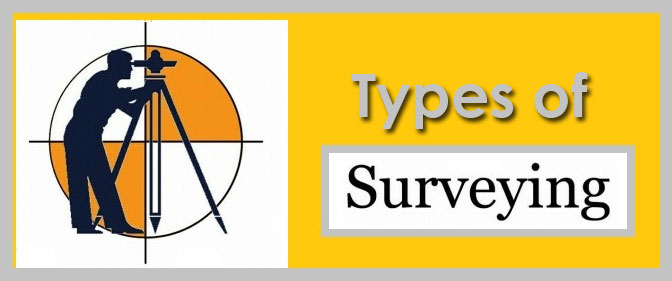
Surveying is primarily classified as under:
- Plane surveying
- Geodetic Surveying
Plane Surveying is that type of surveying in which the mean surface of the earth is considered as a plane and the spheroidal shape is neglected. All triangles formed by survey lines are considered plane triangles. The level line is considered straight and all plumb lines are considered parallel. In everyday life were are concerned with small portion of earth’s surface and the above assumptions seems to be reasonable in light of the fact that the length of an arc 12 kilometers long lying in the earth’s surface is only 1cm greater than the subtended chord and further that the difference between the sum of the angles in a plane triangle and the sum of those in a spherical triangle is only one second for a triangle at the earth’s surface having an area of 195 sq. km.
Geodetic Surveying is that type of surveying in which the shape of the earth is taken into account. All lines lying in the surface are curved lines and the triangles are spherical triangles. It therefore, involves spherical trigonometry. All Geodetic surveys include work of larger magnitude and high degree of precision. The object of geodetic survey is to determine the precise position on the surface of the earth, of a system of widely distant points which form control stations to which surveys of less precision may be referred.
Classification of surveying
Surveys may be secondarily classified under no. of headings which define the uses or purpose of resulting maps.
Classification based upon nature of field:
There are three types of surveying based upon the nature of field which are as follows:
- Land Surveying: It can be further classified as i) Topographical survey ii) Cadastrial Survey and iii) City Survey. It generally deals with natural or artificial features on land such as rivers, streams, lakes, wood, hills, roads, railways, canals, towns, water supply systems, buildings & properties etc.
- Marine Surveying: Marine or hydrographic survey deals with bodies of water for purpose of navigation, water supply, harbour works or for determination of mean sea level. The work consists in measurement of discharge of streams, making topographic survey of shores and banks, taking and locating soundings to determine the depth of water and observing the fluctutations of the ocean tide.
- Astronomical Surveying: The astronomical survey offers the surveyor means of determining the absolute location of any point or the absolute location of and direction of any line on the surface of the earth. This consists in observations to the heavenly bodies such as the sun or any fixed star.
Classification based on object:
Based on object, there are four types of surveying which are as follows:
- Geological Surveying
- Mine Surveying
- Archaeological surveying
- Military surveying
Classification based on instruments used:
Based on various types of instruments used, surveying can be classified into six types.
- Chain surveying
- Compass surveying
- Plane table surveying
- Theodolite surveying
- Tacheometric surveying
- Photographic surveying
Classification based on methods used:
Based on methods adopted, surveying can be categorized into:
- Triangulation surveying
- Traverse surveying

